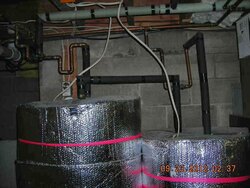Do people still put insulation blankets on a new water heater?
I measured a 3*F temperature difference from ambient and the skin of the water heater.
I'm leaning towards doing it.
I put a 2" piece of foam under the tank, insulated the lines and put in heat traps.
I measured a 3*F temperature difference from ambient and the skin of the water heater.
I'm leaning towards doing it.
I put a 2" piece of foam under the tank, insulated the lines and put in heat traps.



